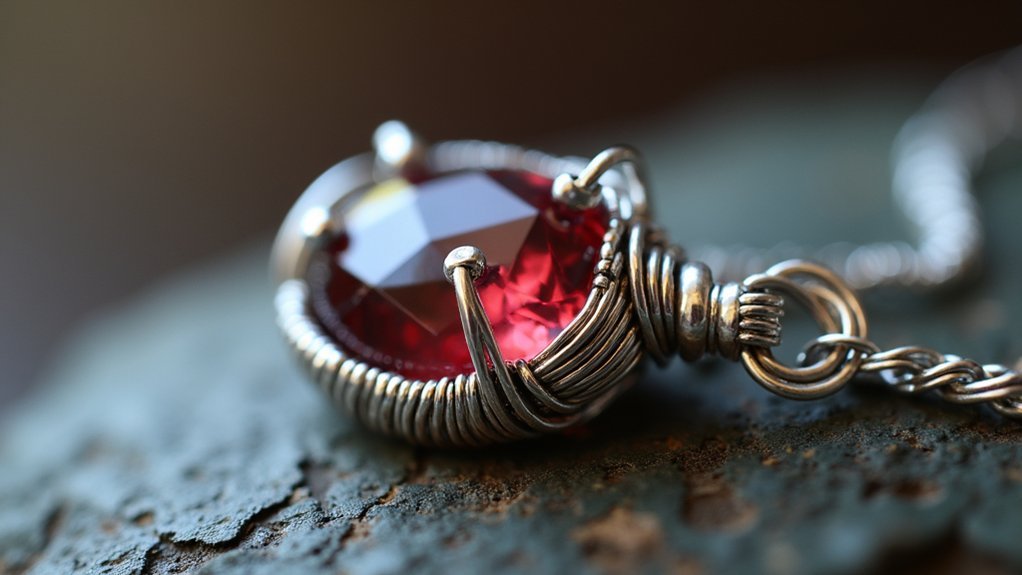You’ll create a secure wire wrapped bezel by selecting the right wire gauge—use 20 gauge for structural foundation and 26 gauge for wrapping. Measure your stone precisely with painter’s tape, ensuring the bezel sits 1mm to 1.5mm above the girdle. Make multiple tight wraps around the top wires and add shims for thinner stones. Square your wire ends for clean joins and apply strategic reinforcement wrapping. Master these techniques to reveal professional-level bezel security.
Essential Tools and Materials for Wire Wrapped Bezels

Success in wire wrapped bezel making depends on having the right tools and materials at your fingertips.
Having quality tools and materials readily available is the foundation of successful wire wrapped bezel creation.
You’ll need chain nose pliers for precise wire manipulation and flush cutters for clean trimming. A ring mandrel guarantees accurate sizing when making bezels for rings.
For wire selection, use 20 gauge for your bezel’s structural foundation and 26 gauge to secure stones within the setting. Magic Bezel Wire works exceptionally well since it’s pre-shaped with a curve that creates a snug fit around stones without holes, making it easier to hold compared to flat gallery wire.
You’ll also want approximately 60 inches of 24 gauge copper wire for wrapping around your structure.
Use painter’s tape to measure the correct bezel length by wrapping it around your stone before cutting your wire.
Proper Wire Gauge Selection and Preparation
While wire gauge selection might seem straightforward, choosing the wrong thickness can compromise your entire bezel’s integrity.
You’ll want 22 to 26 gauge wire for wrapping stone cabochon securely, as this range provides ideal flexibility and strength balance. For structural support, use thicker 20 gauge bezel wire, then apply thinner wire for the actual wrapping to achieve a snug fit.
Ensure your bezel wire sits 1mm to 1.5mm higher than your stone’s girdle for adequate protection.
Preparation matters greatly—square your wire ends for better joins and a polished appearance. This careful preparation contributes directly to your secure wire wrapped bezel’s overall stability.
Practice with various gauges to determine what works best for different stone types and shapes.
Creating the Perfect Fit Around Your Stone

How do you achieve that essential perfect fit that keeps your stone secure without creating unsightly gaps? Start by wrapping painter’s tape around the cabochon to measure the exact length needed for your bezel around the stone.
When making a wire bezel, guarantee your gauge wire extends 1mm to 1.5mm above the stone’s girdle for proper security. The wire ends should touch perfectly without overlapping to create beautiful, clean seams.
During soldering, align the ends precisely to prevent light gaps that compromise stability. For thinner stones, use shims to fill any spaces within the bezel around your cabochon.
This careful attention to fit will help you set the stone properly and secure wire wrapped bezels that last.
Stabilizing Techniques for Long-Lasting Hold
Master the art of wire gauge selection to create bezels that won’t budge over time. Choose 26 gauge copper for smaller stones and 20 gauge for larger cabochon settings to guarantee proper support. Your wire wrapped bezel gains strength through strategic wrapping techniques that stabilize the entire structure.
Focus on multiple tight wraps around the top wires during initial rows. This prevents loops from sliding and creates a foundation that’ll last. Don’t rush this step – each wrap adds vital stability to your bezel’s framework.
For thinner stones, add shims inside the bezel before wrapping. These supports maintain a snug fit and prevent movement that could loosen your secure join over time.
The combination of proper gauge selection and reinforcement wrapping creates bezels that withstand daily wear.
Finishing Touches That Enhance Security

Once you’ve established your bezel’s foundation, the final wrapping stage determines whether your stone stays secure for years to come. Complete your Viking knit tightly around the top wires to create a bezel set that won’t budge.
After your last copper wire wrap, trim and bend it into a bail, spreading wires apart in a v-shape for enhanced security around the stone. Different types of finishing techniques work for various jewelry making projects, but always make certain you’re applying multiple wraps at the bezel’s top.
Regularly assess your completed piece by checking for loosening and reinforcing weak points. Strategic wire around vulnerable areas prevents future problems and guarantees your cabochon remains perfectly positioned within its secure housing.
Frequently Asked Questions
What Are the Different Types of Bezel Wire?
You’ll find bezel wire in copper, brass, and silver materials. It’s available in various gauges like 28 and 32, plus specialty options including magic bezel wire and wires designed for odd-shaped stones.
What Is Wire-Wrapped Jewelry?
You’ll create wire-wrapped jewelry by using wire to securely hold stones or beads without traditional settings. You’ll wrap wire tightly around gems, allowing creative freedom while ensuring they’re held firmly in decorative, functional designs.
What Gauge Is Best for Bezel Wire?
You’ll want 26 gauge bezel wire for most projects since it balances strength and flexibility perfectly. Choose 22 gauge for heavier stones or 28 gauge for delicate work requiring easy manipulation.
How to Harden Wire-Wrapped Jewelry?
You’ll harden wire-wrapped jewelry through work hardening by repeatedly bending and shaping the wire. Alternatively, you can lightly hammer the wire or use gentle heat with a torch to increase strength and rigidity.
In Summary
You’ve learned that mastering wire wrapped bezels requires attention to every detail, from selecting the right gauge wire to perfecting your stabilizing techniques. Remember, you can’t rush the process—take time to guarantee proper fit around your stone and focus on consistent tension throughout your wraps. With practice, you’ll develop the muscle memory needed to create bezels that’ll securely hold your stones for years to come.





Leave a Reply